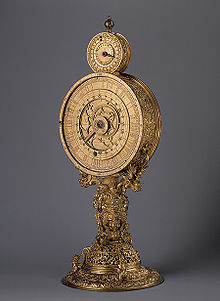Monstrance — Part of the series on Communion also known as The Eucharist , The Lord s Supper Divine Liturgy or Sacrament Theology Real Presence Transubstantiation Transignification Sacramental Union Memorialism Consubstantiation Impanation Consecrat … Wikipedia
Cathedral of Toledo — The Cathedral of Saint Mary of Toledo, also called Primate Cathedral of Toledo, is a church in Spain. The seat of the Archdiocese of Toledo, it is one of the three 13th century High Gothic cathedrals in Spain and is considered to be the magnum… … Wikipedia
Eucharistic adoration — is a practice in the Roman Catholic Church and in some Anglican churches, in which the Blessed Sacrament is exposed to and adored by the faithful. When this exposure and adoration is constant (that is, twenty four hours a day), it is called… … Wikipedia
HAVDALAH — (Heb. הַבְדָּלָה; distinction ), blessing recited at the termination of Sabbaths and festivals, in order to emphasize the distinction between the sacred and the ordinary, with regard to the Sabbath (or festival) that is departing and the or … … Encyclopedia of Judaism
Pyx — This article refers to an object used in Christian church services. For the British coinage procedure, see Trial of the Pyx. Pyx is also the abbreviation for the constellation Pyxis. A pyx or pix (Latin: pyxis , transliteration of Greek: pyxis ,… … Wikipedia
Loreta — is a large pilgrimage destination in Hradčany, a district of Prague, Czech Republic. It consists of a cloister, the church of the Lord’s Birth, a Holy Hut and the clock tower with a famous chime.The construction had started in 1526 and the Holy… … Wikipedia
Luther, Martin — • Leader of the great religious revolt of the sixteenth century in Germany; born at Eisleben, 10 November, 1483; died at Eisleben, 18 February, 1546 Catholic Encyclopedia. Kevin Knight. 2006. Luther, Martin … Catholic encyclopedia
Diocese of Zamora (Spain) — Diocese of Zamora † Catholic Encyclopedia ► Diocese of Zamora (ZAMORENSIS), suffragan of Valladolid. It is bounded on the north by Leon, on the east by Valladolid, south by Salamanca, west by Orense and Portugal. It comprises the… … Catholic encyclopedia
Luther — Martin Luther † Catholic Encyclopedia ► Martin Luther Leader of the great religious revolt of the sixteenth century in Germany; born at Eisleben, 10 November, 1483; died at Eisleben, 18 February, 1546. His father, Hans, was a… … Catholic encyclopedia
Martin Luther — Martin Luther † Catholic Encyclopedia ► Martin Luther Leader of the great religious revolt of the sixteenth century in Germany; born at Eisleben, 10 November, 1483; died at Eisleben, 18 February, 1546. His father, Hans, was a… … Catholic encyclopedia

